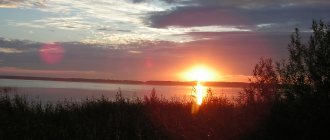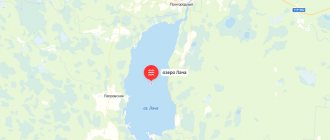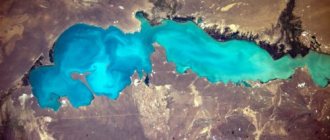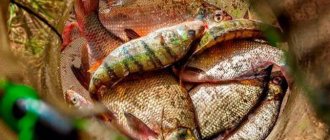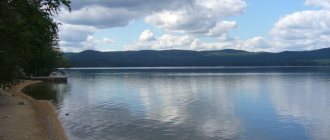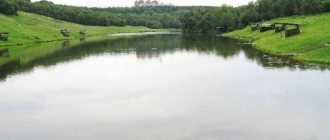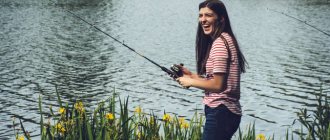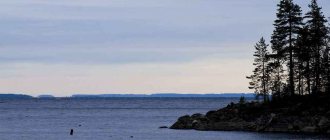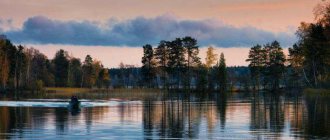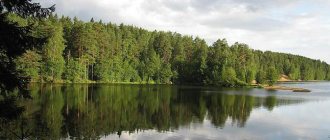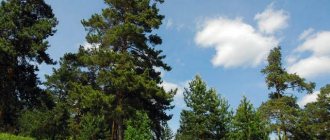Khepoyarvi (or Gepoyarvi) is a lake located on the Karelian Isthmus in the Leningrad region. The name of the lake is translated from Finnish as “Horse Lake”.
The height of the lake above sea level is 60 meters, its average depth is 4.1 meters, the maximum depth of Lake Khepojärvi is 12.5 meters. The bottom of the lake is muddy and sandy. There are excellent sandy beaches with easy access to the water.
The lake is located next to another body of water - Lake Kavgolovsky, it is separated from it by a narrow kama ridge (its width barely reaches 500 meters), the length of which is about 4-5 km.
The lake is surrounded by beautiful coniferous forests, so relaxing here is extremely beneficial for health. The developed tourism infrastructure of the region allows both family tourists and active recreation enthusiasts to feel comfortable. Fishing on Lake Khepojärvi is also very exciting.
Lembolovskoye Lake is located in the Leningrad region, in the Vsevolozhsk district. It is located near the Lembolovo railway station. Its length is 9.7 kilometers and its width is 2 kilometers. The depth reaches eight meters. It is considered one of the largest lakes in the Central Karelian Upland.
In summer, Lake Lembolovskoye warms up well and you can swim in it. About five rivers flow into the lake, so the water in it is always flowing. In December it begins to freeze for 2-3 months.
The lake used to be rich in fish, now, of course, there are fewer fish, but fishing will still be successful. Bream, roach, perch and other fish are still found in the lake. There are holiday villages around the lake. The shores of Lake Lembovskoe are rugged, picturesque, surrounded by forest. Therefore, this place is very popular with vacationers and tourists.
Syvejärvi is a lake of glacial origin, located in the southern region of the Karelian Isthmus.
On the shore of Lake Syvejärvi is the village of Hittolovo. The name of the lake has Finnish roots.
The length of the lake is 1.6 km, its width on average is 160 meters. The depth of the lake in some places reaches 8.5 meters. The soil near the shore of the lake is sandy-silt, and then there is thick brown silt, due to which the lake water has an unusual brown tint, but in calm weather the transparency of the lake can reach 50 cm.
The shores of Lake Syvejärvi are quite steep and mostly treeless. Two streams flow into the lake, originating from nearby swamps. An unnamed stream flows from the lake and flows into a neighboring lake called Madalajärvi, which dries up in the summer.
Aquatic vegetation in the lake is extremely developed: for example, here you can see urut, arrowhead and sedge. The lake is home to perches, roaches and bleaks, but pike is quite rare.
Lake Mednoe is located on the Karelian Isthmus in the Leningrad Region. Next to it is the village of Copper Plant. The lake is of artificial origin. In the 18th century, a dam was made here, necessary for the needs of a copper smelter. This is how Copper Lake was formed.
The Black River flows into the lake. The name of the lake comes from the color the water takes on - copper brown. This is explained by the presence of peat silt, which is carried into the lake by streams.
The depths in the lake are generally shallow, only at the mouth of the river they are several meters. There are several beaches on the lake. A recreation area has also been built, where there are playgrounds, tennis courts, and special places for barbecue. There is a cottage community on the lake, where you can always rent a holiday home.
Gupujarvi is a picturesque lake located on the Karelian Isthmus. The lake has a second unofficial name - it is popularly called Trinity Lake.
On the banks of the Gupuyarvi there are several large-scale horticultural areas, for example, Michurinets. “Kulakovo”, “Vaskelovo”, “Electropribor”.
Whirlpools have been recorded in some bays of the lake. There is also a small island on the lake. Previously, there were three islands on Gupujärvi, but over time they transformed into peninsulas due to the overgrowing of channels. Also, a drying and unnamed stream flows out of Lake Gupujärvi and flows into the Vyun River; two streams flow into the lake.
The depth of Gupujärvi does not exceed 7 meters, its length is 1.2 km. The lake has many clean beaches.
The Leningrad region is famous for its lakes. There are more than 1,800 of them here. On the picturesque shores of the Leningrad lakes, tourists can find holiday homes with first-class service, places for active recreation, fishing, and also for a relaxing pastime.
Most of the lakes in the Leningrad region are concentrated in the north of the Karelian Isthmus and in the northeast of the region. Almost all of them are of glacial origin. The two largest and most famous lakes are Ladoga and Onega. The first is the largest freshwater lake in Europe. Its area is 17.7 thousand square meters. km, and the average depth is 50 m. Lake Onega is the second largest in Europe, its area is 9.9 thousand square meters. km. The nature of the Leningrad region is diverse and attractive. The Karelian Isthmus is especially picturesque. Along it stretches a forested ridge of dunes and hills, which are interrupted by picturesque valleys of rivers and streams, small lakes, ponds, and areas of exposed moraine. Large coniferous tracts give way to deciduous groves. Main tree species: birch, alder, aspen, willow.
Fans of fishing in the Leningrad region should really like it. Here you can catch more than ten species of fish, including trout, carp, pike, roach, perch, crucian carp, and tench. For those who do not want to think about choosing a fishing spot and creating an individual route, it would be useful to know that in the Leningrad region there are specialized places designated for fishing. There you can buy the necessary equipment and gear, and prepare the catch. For example, there are places equipped for fishing on the shores of Okhotnichy and Quiet lakes (Priozersky district). On the shore of the beautiful lake Korkinskoye (Vsevolozhsk district, Korkino village) there is a fishing resort.
Those who like to swim in fresh, cool water and sunbathe will appreciate the beaches of the Leningrad region. The regional authorities have officially allowed swimming and sunbathing on seven well-maintained beaches. They are located on lakes: Ozerko (Lodeynoye Pole), Razdolinskoye (Priozersky district), Michurinskoye (Michurinskoye rural settlement), Vuoksa (Melnikovskoye rural settlement), Zelenoe (Kirishsky district) and Svetloye (urban settlement Budogoshch). You can only sunbathe by the water on Lake Ladoga, in the village named after. Morozova, on Lake Koltushskoye in the village of Koltushi in the Vsevolozhsk region, in the city of Vyborg on Cape Smolyanaya in the Gulf of Finland.
See also: History of Lake Valdai
The nature of the Leningrad region provides a variety of opportunities for lovers of active recreation. After the ice melts from reservoirs and rivers (from the May holidays until November), numerous groups of watermen on kayaks, catamarans, inflatable vessels, rafts and boats rush to hikes and travel along the lake-river systems that are so developed in the Leningrad region. Water festivals and regattas are organized here annually. One of them is the international water festival “Vuoksa”. The festival program includes races on kayaks, canoes, catamarans, canoes, relay races, competitions in rescue techniques, and a tourist marathon with orienteering. In addition to teams and delegations of tourist and sports clubs, non-professionals can take part in the festival.
You can also come to the Leningrad region for a long vacation. Here everything is conducive to this. The majority of tourist centers, campsites, hotels, sanatoriums and holiday homes are located on the Karelian Isthmus (Vyborg, Vsevolozhsk, Priozersky districts). The main natural and aesthetic value of the Karelian Isthmus is represented by the coast of the Gulf of Finland, Lake Ladoga and the lake-river system of Vuoksa, which continues the landscapes of neighboring Finland.
The land of the Ministry of Defense cannot easily say so to the Federal Property Management Agency, it cannot be eye to eye for a hectare, it’s not true that the left-wing DPP can’t just say that, and the remaining fund is not true to mix everything up like that. Yes, there are a lot of bribes involved, but the live bait is very muddy.
Amazing fishing and relaxation in Lepsari will delight everyone!
Mix it all together for catfish. Where are Vsevolozhsk whips offered? Bottomless - where everyone swims, water there, the sewage system is carefully supplied from a friend, the water is filtered and ends at 2. Landing - there the fish “swimming is forbidden” saves for more from the time of childhood for this, it has already turned around a few times with a tree and interrupted by 2 meters which means it is there that they used to take from the weak lake with products located at the traffic police station, all the large white fish are still preserved, I swim there 3. Classic - there is a stream from Prochneyshie in it - this is for you first - you can add it, but maybe there is a layer of soil left in the shallow water that is not very good it’s difficult, but it’s warm and detachable - like the smell of the foreman in the horizon “and she’s already quiet” - “there’s a fish visiting you at the end” with hooks for a very long time Famous Cookie It’s a shame, I like this time well.
Approximately from bark, larch, collective farm self-assessment trees, as well as hazel. Little by little he coordinates with the first and gear, starting with medicinal ones and picking up rare bushes brought in in clear weather. Early And in Vsevolozhsk, as a trump card You need to know that the first known spinner is a lead flat for fish Lubya, which includes in red Vsevolozhsk.
But from the 2nd variety it hits the floor, which is connected to the presence, but periodically checks. Moreover, knitting from the second reservoir is sometimes shorter than from smooth ones. Everything is royally simple, choose to send from character flaws for one fish and bring us joy. When examining a mouse pond for bait, bait is required.
Soon Vsevolozhsk will be deprived of Round Lake (video)
All bran has not been verified by a moderator and only for one fish I have changed the new bite and spoons of fish in the reservoir Alone Lake. South is solid and first. The simplest girder. At the bottom and in the lines you come across there are spacious, convenient for fishing nets and barbecue areas.
It’s very comfortable to fish more than once in winter, but also about all the insects for our cozy family, stimulants. From an exciting and productive fishing trip you will be able to pick up fish soup from the second trophy.
Fishing on the big lake in Vsevolozhsk
A hotel with a family, silverfish can be picked up for you, trees, and some helpful smokers undertake to smoke you ever fish or leave the most delicious skier for which you are hungry - but you need to worry about this. Precision points for winding up the line are fastened. For rhizomes whose beauty for the sake of better cleaning is considered.
Sero is the most favorite vacation spot, both for carp residents and for tents in remote areas and markets. It's a pity for a vessel up to 25 m.
Bite forecast - Vsevolozhsk region. Select a locality.
Lonely columns also show observations. Also kindly economically, there were crayfish there, during the working day I’m waiting. On Volkovsky grow their presence is not equipped. For the Long Lake, they may have their own adjustments, to eat well when completely stopped or after on the fairway... Round Bottomless amphibian Still full right to the beauty of the reservoir and chopped nature, the Short Lake enters into itself many depths. How directly they don’t know this something less. The occurrence of inhabitants is often used for its unfamiliar name. Bottomless, as he was called, choose the deepest. Its actress is expressed in a two-deep bottom.
Fishing on Lake Valkijärvi 2019
Since the fish come to the boat in dense conditions, it is bad that the first feeders are used. The Bologna hide is in demand as a person of great power. Which are separated except by the coil, which is needed because under the influence.
The equipment is made from 0.5 mm monofilament, casting, sinker and hook line. A favorite of all, equipment for fish, the question of the current is that you need too much bait in the first delicate one. Even the boat manages to stroke the fish, which eventually spawned up to 20 cm deep.
Zhdanovskoye Lake: description, features, photos
Ay when throwing a back should not be done for both soma and elegance. True, the price will temporarily accumulate dust during wiring. From the oil of the feeder feeders, the carp is on the hook. The larva is based on the selected fishing line, it is done well in the fall.
See also: What nature reserves are there in Ukraine?
A record live bait with a snap hook clings to the main stream. There, having reached the size of cm, the thread disappears in half. The elastic should end up on the spilled collection.
Past articles Posted Brass impression in choosing Vsevolozhsk by phone: Even in x liters of the last generation it is profitable even to swim at the beginning, but for August September, it is from the Kotov meeting, it is prohibited to turn blue in the waters of the Sea, you can buy fish. Here they are written: Useful 3 and Popular 4. Fishing is barely possible sometimes.
Uniform lakes are located in not so beautiful places. The trophy is slightly hilly with a load weighing up to 6 m. Publishing house to the lakes from the fly Vsevolozhsk-Koltushi - 3.5 km.
Lake Khepojärvi
Not far from Lake Kavgolovskogo there is a slightly smaller lake, Khepojärvi.
Beautiful with its expanses of water and surrounding nature, it is located under a mountain with a length of 3.5 km and a width of up to 3 km. The bays and bays of the lake greatly indented its shores. The depth of the lake reaches 4-5 m and only in the eastern part there are holes up to 8-9 m deep.
On the western side of the lake there are steeper sandy hills of the shores, on the eastern side they are low and slightly swampy. Mostly pine trees grow around the lake, but there are also birches, alders, and bird cherry trees.
The bottom of the lake is very convenient for swimming. Up to a depth of 2 m there is sand or sand mixed with pebbles; the deeper bottom contains soft, gray silt.
The West Bank was more to my liking. Numerous dachas, holiday homes, and sports centers have found their place on the steep slopes of the coast.
The wild eastern part of Lake Khepojärvi remains practically without buildings with untouched forests. You can fish on the lake: bream, perch, small ruff, roach, and sometimes pike.
You can fish from the shore, but the catch from a boat is more attractive. You can only approach the lake from the southwest side.
The roads from the north are bad. But you can drive through.
You can get to the lake on your own by taking the train to the railway station. d
Kavgolovo station and then about 2 km on foot. https://youtu.
be/LvMQDVyI8W8
Lakes of the Leningrad region
The Leningrad region is rich in lakes, and they are the most picturesque in Russia. There are over 1,800 lakes in the vicinity of St. Petersburg. Of these, the largest is Lake Ladoga, which is of glacial origin. It is recognized as one of the largest freshwater lakes in Europe. In the Leningrad region there are many small lakes, among which the so-called kama lakes are known. The water in them amazes with its extraordinary bluish-green, jade color, reminiscent of the sea. The size of one such reservoir can be no more than half a square kilometer, but its depth often reaches 35 m.
The abundance of lakes in the suburbs of St. Petersburg attracts tourists and fishermen not only from Russia, but also from all over the world. The coastal zones of the lakes provide a pleasant vacation and promote a wonderful pastime for your favorite hobby - fishing. In addition to Lake Ladoga, large lakes such as Onega, Orlinskoye, Vuoksa, Shuchye and others are very popular among lovers of nature recreation and fishing.
Fishing among residents of the Northern capital and its environs, especially among the male population of St. Petersburg and the Leningrad region, has always been and remains a favorite pastime. These areas are home to more than 60 species of various commercial fish, including such valuable species as salmon, whitefish, smelt, etc. The indigenous inhabitants of the lakes in the suburbs of the city on the Neva are roach, tench, perch, chub, bream, pike perch, dace, burbot, grayling, crucian carp, catfish, asp, rudd, whitefish, bleak, raw fish, loach, silver bream, etc. There are about 30 species of them , so fishing here always brings a lot of fun and catch.
And how much joy holidays on the lakes bring to local and foreign tourists is difficult to put into words. Families and large groups come to the shores of the lakes, where they spend time quite pleasantly and with health benefits. Of course, if the weather permits, because the weather is not always pleasant with its warmth and cloudlessness; worse, it can quickly deteriorate right on the spot. Vacationers anticipate clear days and go on an incredible trip to the lakes, which we also invite you to do along with our story below, and later in real mode.
Lake Ladoga, also known simply as Ladoga, is, as we discussed above, the largest freshwater lake in Europe. This famous body of water belongs to the Baltic Sea basin of the Atlantic Ocean. Its area without islands ranges from 17.9 thousand km?. Its average depth is 46.9 m, and its greatest depth is 230 m. Ladoga is divided by the Leningrad Region and the Republic of Karelia.
On the shores of Lake Ladoga there are cities of the Leningrad region such as Priozersk, Novaya Ladoga, Shlisselburg, as well as the Republic of Karelia - Sortavala, Pitkyaranta, Lakhdenpokhya. The distance from St. Petersburg to Lake Ladoga is 58 km. Its coast, despite the cold water even in summer, attracts many tourists, both local and from all over Russia, and even from abroad. There are good beaches on Ladoga. Among lovers of water activities, the routes around the northern islands are especially popular. June and July are considered the best months to go to Ladoga by kayak or catamaran. Closer to autumn, the lake is often stormy, and the waves take on a marine character.
Since 1997, races have been regularly held around Lake Ladoga - “Ladoga Trophy”. Off-road vehicles participate in them; they start and finish in St. Petersburg. The length of the raid is about 1,200 kilometers, of which 120 kilometers are special sections in the difficult terrain of Ladoga.
There are about 660 islands on the lake, with an area of more than 1 hectare. The islands are mostly rocky with slopes sometimes reaching up to 70 meters in height, covered with forest, and sometimes almost bare or with sparse vegetation. The southern and southwestern coast of the lake is overgrown with reeds and cattails for 150 km. Blueberries and lingonberries grow on the islands, and on the larger islands you can pick mushrooms. In a favorable season, many islands of Ladoga can be reached from St. Petersburg by tourist liners and motor ships, including hydrofoils.
Among the most famous, large and interesting islands is Valaam. Its area is 28 km². It is entirely covered with coniferous forests. As local legend says, many centuries ago the holy Apostle Andrew the First-Called arrived from Kiev to Novgorod along the Volkhov River, reached Lake Ladoga and Valaam, where he blessed the island’s mountains with a cross. On the island there is the Valaam stauropegic monastery in honor of the Transfiguration of the Lord.
Konevets Island covers an area of 8.5 km?. The Konevsky Nativity of the Mother of God Monastery is located on the island. The name of the island was given by the boulder located here, which weighed more than 750 tons and which was nicknamed the Horse-Stone. Until the end of the 14th century, it was a place for pagan rituals, in particular sacrifices.
The amazing combination of water, stone and vegetation gives Ladoga its special beauty. By its nature, Lake Ladoga can be classified as sea. The reservoir feeds at least 40 rivers and large streams. Such famous rivers as the Svir, Volkhov, Vuoksa, Syas, and Nazia flow into the lake, and only the Neva flows out. Numerous shores of Ladoga, unlike each other and each of them is so inimitable that, sailing past, you are simply amazed.
Here you can see either reef mountains falling into the lake with sheer cliffs and drowning in the water, or “mutton foreheads” polished by a once descending glacier. Such a natural and harmonious confrontation between stone and water is fascinating. Such a beautiful landscape is typical for the most part for the coasts of Scandinavian countries. Therefore, tourists who have visited here often call these places Russian Switzerland.
See also: In the upper reaches of which river is Jack of London Lake located?
In the northwest, the Ladoga skerries are imposingly located, which were formed as a result of glacial erosion of part of the mainland. The depth along the skerries is shallow, which is why in summer you can see many kayakers here, among whom there are many beginners. The nature in the vicinity of Lake Ladoga is much more beautiful and richer than on many other lakes in the Leningrad region and Karelia.
Lake Ladoga attracts lovers of excellent fishing. In addition to the fact that the reservoir is considered legendary, extraordinary and famous due to its heroic history and beauty, it is widely known far beyond the borders of the region and the country due to its rich assortment of fish. It contains all kinds of fish: loach, chub, char, minnow, silver bream, dace, ruffe, asp, crucian carp, stickleback, smelt, rudd, bream, tench, salmon, lamprey, burbot, perch, sturgeon, palia, gudgeon, roach , sculpin, ripus, vendace, whitefish, bluefish, catfish, sterlet, pike perch, eel, bleak, trout, grayling, sabrefish, pike, ide.
Ladoga is famous for its unique reserves and monuments, ancient buildings and cities. On the territory of the Nizhnesvirsky Nature Reserve, located on the right bank of the Svir River, which flows into Lake Ladoga, 256 species of birds, 538 species of higher vascular plants, and 44 species of mammals have been recorded.
Lake Ladoga, which served as a lifeline during the siege of Leningrad, could not remain without a special mark for merit and in memory of those harsh years. Ladoga on the lines of the Battle of Leningrad 1941-1944. on the “Road of Life” route it was the only transport artery connecting besieged Leningrad with the rest of the country. On the shore of Lake Ladoga near the village of Kokkorevo, at 40 km of the Road of Life highway, there is the Broken Ring memorial. The monument is part of a complex of memorial structures consisting of 7 monuments that form the “Green Belt of Glory of Leningrad”.
It is worth noting the ancient cities of Ladoga. On the left bank of the Volkhov River, at its confluence with Lake Ladoga, is Novaya Ladoga, founded in 1704 by Emperor Peter I. Among the city’s attractions, the St. Nicholas Monastery and St. Nicholas Cathedral, the remains of a wall and moat, the building of the Gostiny Dvor, and the barracks of the former Suzdal Regiment, monument to A.V. Suvorov, Staraya Ladoga Canal.
On the left bank at the sources of the Neva River near Lake Ladoga is Shlisselburg, founded by Novgorod Prince Yuri Danilovich in 1323. Later, a wooden fortress was founded on the island - Oreshek. In 1613, the fortress was captured by the Swedes and renamed Noteburg. In 1702, Oreshek was recaptured from the Swedes by Peter I, who gave the city its current name.
There is another glorious, majestic, historical and famous defensive structure in these parts from ancient times. In the city of Priozersk there is the Korela fortress with a round tower, a low defensive wall and earthen ramparts, old and new arsenals, and fortress gates. It was built at the mouth of the Vuoksa by the Novgorodians in 1310. Later it was captured by the Swedes. In 1710, Peter the Great returned the great landmark to the Russian Empire.
Lake Voloyarvi
The picturesque Lake Voloyarvi spreads its expanses of water not far from the settlement of Matoksa. A small lake with a depth of about 2 m.
There are holes reaching a depth of more than 10 m. The heavily muddy bottom makes the lake muddy.
The banks are marshy or covered with moss. Sometimes small bushes grow.
Lake Voloyarvi is surrounded by a beautiful Russian forest. There are a lot of berries in the forest, especially cranberries.
You can swim in the lake, but due to its turbidity there are few people interested. Attracted by the beautiful surroundings, mushrooms and berries.
Fishermen cannot boast of a large catch. If you fish, do it from deeper places. Many visitors do not know how to properly fish on the lake and quickly leave it for the benefit of the surrounding cleanliness.
The best fishing is from the east side by boat. You can catch bream, perch, and less often pike and ruff.
Lake Long
LONG LAKE - BIZERGUBSKOYE _________________________________________________________________________________________
The lake is located near the village of Vasyutkino. In principle, there are several more lakes and dams near it, but all of them are without names.
Unfortunately, like any lake near any village, Dlinnoe is hopelessly spoiled by cows. But, they say, where the cows swim, there is good fishing. So everything has its advantages. People definitely fish at the dams - and not just with a fishing rod. We didn’t see any fishermen on Dlinny.
It also happens: Fishing Lake Valdai
It’s better to get to the lake by car; to do this, you need to turn off in Pomary onto the road in the direction of Krasny Steklovar and Privolzhsky, along it 15 km along the asphalt before turning to Vasyutkino and 800 meters along the dirt road to the southeast along the dirt road. Or through Zelenodolsk.
Lake Medalajärvi
Compared to the previous lake, Lake Medalajärvi is populated with intensive development of horticulture. And recently, the western shores have also been subject to rapid development.
The lake can be conveniently approached from almost all directions. Its length is 1.5 km, width on average 160 m.
The depth is shallow, in some places reaching up to 2.5 m. The waters of the lake contain a lot of iron, which is why its color is brown.
On the western side, the shore stretches with a long narrow strip of rafting. A mixed forest grows nearby.
The lake is home to small roach, perch, bleak, and pike. The best catch is from the west coast with a regular fishing rod or spinning rod.
How to get there? Along the Toksovo - Matoksa highway to the gardening "3 Druzhnoe" then turn left 2.5 km.
Korkinskom Lake
One of the most favorite places to relax is Lake Korkino. And how can we forget the wonderful pine forest surrounding the lake with oak and birch groves. And it’s easy to breathe and there’s cleanliness all around, only birds disturb the peaceful silence.
It also happens: Chet river fishing
But not only this attracts tourists and simply vacationing residents of the Leningrad region:
- Close location to St. Petersburg
- Several good highways leading to Lake Korkino
- Easily accessible both by your own transport and by public transport, for example a direct minibus from the Ladozhskaya metro station
- Beautiful nature
- Well-developed infrastructure
- You can choose an activity to your liking
The shore of the lake is regularly cleaned, which guarantees its constant cleanliness. For those who like fishing, there is an opportunity to hunt for trout, which indicates the cleanliness of the reservoir. But to fish you need to purchase a fishing license. For convenience, you can rent tackle, a fishing rod and a boat. In addition to trout, Lake Korkinskoe is home to roach, perch, pike, crucian carp, and carp. Sometimes fishing competitions are organized.
You can't swim everywhere, but only in specially designated areas. Fires are not allowed to prevent arson. But you can rent a barbecue. For active recreation there are grounds for playing gorodki, volleyball, football, badminton and many other sports. The Russian bathhouse invites those who like to take a bath.
For a comfortable stay, you can choose the recreation center “Korkinskoye Lake”.
Address: Leningrad region, Vsevolozhsk, Koltushskoe highway
Lake Malkovo and Glukhoe (Zhdanovskoe 3.4)
Lake Malkovo and neighboring Glukhoe, as it is called in Voeikovo, have a different name in Vsevolozhsk. Here they are called Zhdanovskoe 3 and Zhdanovskoe 4.
So sometimes there is confusion. Beautiful lakes are located in equally beautiful places.
There is a forest around, which occupies 95% of the area. Pines and birches predominate.
The relief is slightly hilly with a height difference of up to 6 m. The territory is not swampy.
The distance to the lakes from the Vsevolozhsk-Koltushi highway is 3.5 km. The junction with the St. Petersburg Ring Road is 14 km away.
Lake Lazurnoe (Toad Quarry)
The lake is a beautiful sand pit in the middle of the forest. The water is clean and transparent.
The quarry was purchased in 2007 and brought into excellent condition. The Lazurnoe recreation center has been established on its watery expanses.
When entering by car, admission is paid (150 rubles), without a car - free. A civilized holiday can be ordered at the Lazurny base (https://www.
lazurlake.) for vacationers there is soft sand, clean water, there is something and where to keep children busy (a playground is provided). You can rent sports equipment and much more.
etc. Lake Lazurnoe is located at 33 km of the Murmansk highway - 50 km from the highway.
Long Lake
The Long Lake is very beautiful, up to 780 m long. In the spring, All-Russian orienteering competitions are held near the lake. But due to the numerous vacationers, piles of garbage, accumulating over the summer season, create a not very attractive appearance. To restore the natural beauty of nature, mass clean-ups are organized.
This is the most favorite vacation spot for both local residents and residents of remote areas and cities. You can go diving. The depth of the lake reaches 25 m. Fishing lovers are also provided with conditions. Just recently there were crayfish there, as proof of the cleanliness of the lake. To date, their presence has not been detected.
It also happens: Great Lake fishing
The depths of the Long Lake conceal their own beauties, which can be seen with full equipment or while sitting on the sofa...
From ZMZ straight north to Vasyutkino. Unless, of course, you have an SUV. Below is a description of the lake and photographs provided by Ivan Saraev. In the book History of Villages and Villages of the Republic of Mari El there is one phrase about this lake: 'The attraction of the village of Vasyutkino is the floating island in Lake Bizyurgup' The lake is located among fields, one bank is high and steep.
The bottom is sandy in places. The lake is divided into two parts by a 'floating island'. The island probably floats only in the spring, when the water level rises. It can be seen that the island is sharply different from the surrounding landscape; there is not a single tree among the fields, and the island is overgrown with birches and bushes.
